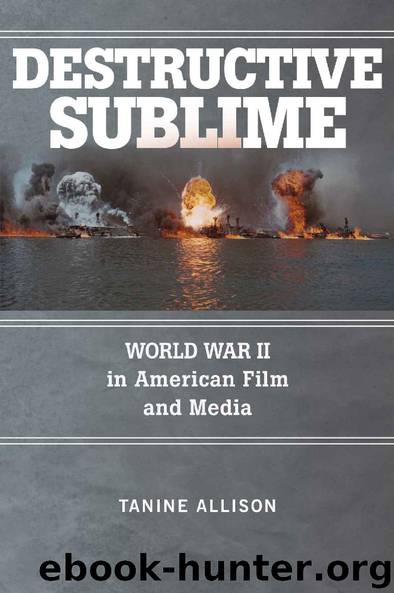Destructive Sublime: World War II in American Film and Media (War Culture) by Tanine Allison

Author:Tanine Allison [Allison, Tanine]
Language: eng
Format: epub
Tags: SOC052000 Social Science / Media Studies, HIS027100 History / Military / World War Ii, PER004120 PERFORMING ARTS / Film / Genres / Historical
ISBN: 9780813597485
Publisher: Rutgers University Press
Published: 2018-06-24T23:00:00+00:00
Conclusion
Darryl F. Zanuck’s “daring, impossible undertaking” to re-create a piece of World War II without documentary footage led to a cycle of films following its aesthetic pattern. Films like The Longest Day, Battle of the Bulge, Tora! Tora! Tora!, and A Bridge Too Far replaced documentary images with large-scale reenactments and rejected the amateurish, fragmented style of combat cinematography in exchange for the polished, abstracted views of the remote perspective. This style allowed the films to explore aspects of the destructive sublime associated with size and quantity as well as massive force and violent power. The new style of combat sequences mirrors the films’ narratives, which dramatize the administrative machinery of the military. Reflecting the conditions of the Cold War, these films depict the German and Japanese commands as intellectual, rational, and respectful of authority and tradition, inexplicitly rejecting the presumed disorder and classlessness of Communism. The films present military campaigns as a series of interconnected episodes determined by the logical deductions and strategic planning of a hierarchy of officials. The combat aesthetics of The Longest Day and its followers are also the product of intensive planning, international diplomacy, and rational decision-making, if on a smaller scale. The visual style of remote viewpoints, abstracted camera positions, smooth tracking shots, and balanced, holistic framing grounds its authenticity in an approximation of objectivity rather than relying on the subjective, individual experience of combat. This style matches the films’ portrayals of the military as an institution governed by rules, rationality, and leadership.
The World War II reenactment films in this period sought to clarify the moral virtues of the war, but they did not do so by giving speeches about “why we fight,” the villainy of the enemy, or the larger meanings of the war. Rather, they illustrated a particular conception of righteousness in their very form, by demonstrating the rationality, the predictability, and the clarity of war—what happened when, what the causes were, and why things unfolded as they did. This philosophy of reconstructing the war reflects a popular mythology of the Second World War, whose apparent moral clarity produces clarity in knowledge, cutting out the fog of war and making causes, effects, characters, and places all clear.
But this approach to war did not reflect the contemporaneous conflict in Vietnam; instead, it deflected it. The narrative of Tora! Tora! Tora! tries to hold on to the mythic story of the Second World War, presenting the U.S. military as a rational force that relies on information and the chain of command, even when it fails. However, difficulties in its production and the sometimes inconsistent narrative and combat aesthetics show that the conventional narrative of the “good war” had begun to break down by 1970 as a result of the Vietnam War. In order to represent Vietnam, even allegorically, at this point in time, the genre had to break with convention, integrating elements of other genres. Kelly’s Heroes uses elements of the Western and the heist film, and black comedy allows The Dirty Dozen, Catch-22, and MASH to comment on Vietnam and the corruption of the military establishment.
Download
This site does not store any files on its server. We only index and link to content provided by other sites. Please contact the content providers to delete copyright contents if any and email us, we'll remove relevant links or contents immediately.
| Anthropology | Archaeology |
| Philosophy | Politics & Government |
| Social Sciences | Sociology |
| Women's Studies |
Cecilia; Or, Memoirs of an Heiress — Volume 1 by Fanny Burney(32413)
Cecilia; Or, Memoirs of an Heiress — Volume 3 by Fanny Burney(31826)
Cecilia; Or, Memoirs of an Heiress — Volume 2 by Fanny Burney(31815)
The Great Music City by Andrea Baker(31252)
We're Going to Need More Wine by Gabrielle Union(18952)
All the Missing Girls by Megan Miranda(15505)
Pimp by Iceberg Slim(14329)
Bombshells: Glamour Girls of a Lifetime by Sullivan Steve(13954)
Talking to Strangers by Malcolm Gladwell(13196)
Norse Mythology by Gaiman Neil(13177)
Fifty Shades Freed by E L James(13146)
For the Love of Europe by Rick Steves(12679)
Mindhunter: Inside the FBI's Elite Serial Crime Unit by John E. Douglas & Mark Olshaker(9165)
Crazy Rich Asians by Kevin Kwan(9148)
The Lost Art of Listening by Michael P. Nichols(7389)
Enlightenment Now: The Case for Reason, Science, Humanism, and Progress by Steven Pinker(7177)
The Four Agreements by Don Miguel Ruiz(6604)
Bad Blood by John Carreyrou(6525)
Weapons of Math Destruction by Cathy O'Neil(6117)
